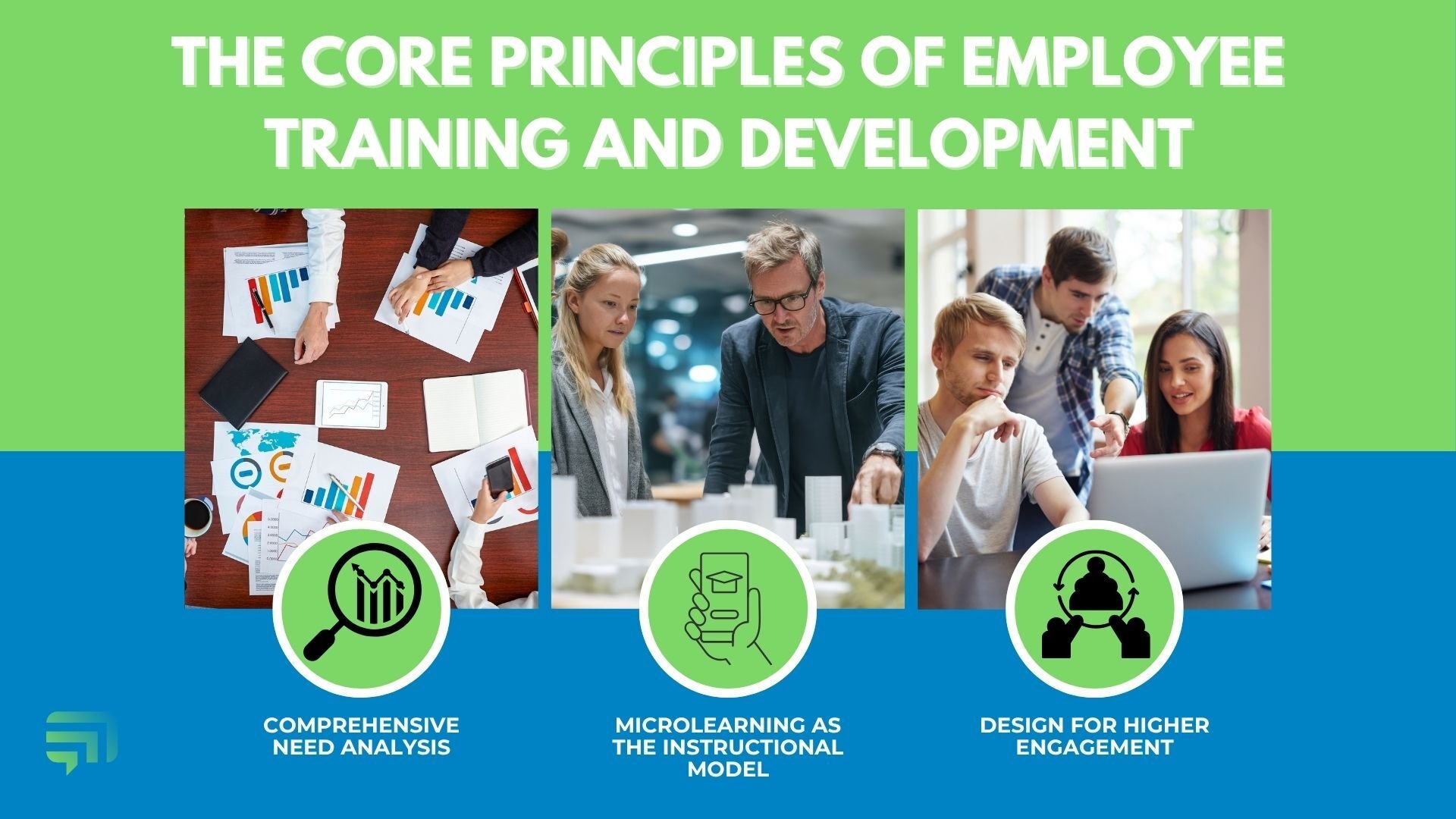Share this
What is Employee Training and Development? [Easy Guide 2025]
by Tee Dang Mankiewicz on Oct 15, 2025 11:40:30 AM
In today’s volatile business climate, employee training and development are no longer a discretionary perk; it is a prerequisite for organizational success. Organizations that invest in their workforce experience higher productivity, stronger employee retention, and a steady leadership pipeline ready to address tomorrow’s challenges. In contrast, companies that neglect it experience rising turnover, disengagement, and a competitive disadvantage in recruiting top talent.
Employee training upskills individuals with the technical skills and knowledge required to accomplish their current KPIs (Key Performance Indicators). It offers compliance programs, software proficiency, and process improvement initiatives to future-proof the workforce.
Whereas employee development is forward-looking. It nurtures future capabilities, such as leadership, problem-solving, and adaptability, ensuring that employees grow in parallel with the organization's needs. Training builds competence, development builds capacity. Hence, both are essential for organizational excellence.
The following blog goes beyond theory. Throughout the article, you will find practical resources on how to implement time-blocking for sharper productivity, deploy Brasstack’s leadership toolkits to build a management pipeline, apply coaching and mentorship models, and adopt strategies to improve employee engagement and retention. Each section elaborates on a standalone resource while collectively shaping a comprehensive approach to foster a culture of continuous learning.
Ever wondered why it is important to organize employee training and development programs in the organization? Employee training and development have become a strategic imperative for organizational excellence. It makes the workforce future-ready and makes strides in the highly competitive business environment.
What is the importance of Employee Training and Development?

Today, the workforce demands more than transactional skills. They anticipate continuous opportunities to expand their capabilities, and organizations that deliver on this expectation gain a measurable competitive advantage. Training and development align employee aspirations with organizational performance goals.
Targeted training develops the skills required to succeed in current roles, while development programs foster career growth and mobility. Organizations that offer structured learning opportunities report higher engagement, stronger confidence in their abilities, and a clearer sense of purpose at work. Training and development reduce role ambiguity, cultivate resilience, and adaptability in the face of change.
Companies that prioritize employee development consistently outperform peers in productivity, innovation, and customer satisfaction. It reduces employee turnover costs by improving retention, strengthens succession planning, and accelerates the time-to-performance of new hires. Research indicates that organizations with strong learning cultures see a direct correlation between employee performance metrics and long-term profitability.
Employee training initiatives are the strategic lever for growth. One of the most effective ways to foster a culture of continuous learning is through structured coaching and mentorship programs. They are the proven approaches that create accountability, foster knowledge transfer, and ensure leadership readiness.
Our dedicated guide on Employee Coaching and Mentorship explains how to integrate coaching programs into your development strategy. To ensure the impact of the employee training program, you must learn the components of an effective employee training program.
The Core Principles of Employee Training Programs

Creating a training program that ensures measurable outcomes requires more than instructional design and content creation. It requires a disciplined, evidence-based approach. The most effective organizations follow three core principles: thorough need analysis, microlearning, and engagement design.
Start with a Comprehensive Need Analysis
Every successful program begins with clarity. Conducting a structured needs assessment allows organizations to identify critical skill gaps, align training with business objectives, and avoid the common mistake of offering generic, off-the-shelf modules. The following diagnostic step ensures that training investment is directed toward capabilities that directly impact performance and growth.
Adopt Microlearning as the Instructional Model
Modern employees rarely have the bandwidth or patience for hour-long training sessions. Therefore, you must use microlearning as the instructional strategy. It delivers content in short, digestible modules to improve completion rates, employee retention, and on-the-job application. It breaks training into five-to-ten-minute segments to make learning frictionless and accessible, whether employees are at their desks or on mobile devices.
Design for Engagement, not Compliance
The difference between training that sticks and training that falls often comes down to engagement. Interactive quizzes, text-based learning, gamification, mobile learning and real-world application exercises drive higher levels of participation and knowledge retention. Engagement is not an add-on; it is the proven mechanism through which training leads to behavioral change.
If you are seeking to build a blueprint for success, you can explore our in-depth guide on the secrets to developing an effective employee training program. It breaks down each principle into actionable steps, with examples of how leading companies have applied these to yield incredible results. Brasstacks is committed to upscaling your training programs through the implementation of the core principles.
Based on the need analysis, you must develop employee training programs. However, there are some essential training programs that you must organize to help your managers and employees.
What are the essential training programs for effective management?
Managers sit at the intersection of strategy and execution. Their ability to lead teams, resolve conflicts, and drive performance determines whether an organization thrives or falls. Yet too many managers are promoted on technical merit without the structured training needed to excel in leadership roles. Every great manager isn’t an effective leader.
An effective management training should cover core competencies that directly impact team productivity and culture. Here are some of the training programs that can help in improving the leadership capacities of your managers:
- Communication Skills: Training in clear, concise, and empathetic communication reduces friction, prevents misalignment, and builds trust across teams.
- Time Management: Techniques such as time blocking and task batching help managers allocate attention to high-value activities, ensuring that strategic priorities are catered to amidst the day-to-day firefighting.
- Conflict Resolution and Negotiation: Modern managers must be equipped to navigate disagreements constructively. They must balance individual needs with the organization’s strategy.
- Coaching and Feedback: Managers should learn how to coach subordinates for growth, deliver feedback that inspires change, and recognize achievements that drive motivation.
- Emotional Intelligence: Training that builds self-awareness, empathy, and relationship management enhances a manager’s ability to lead diverse, multigenerational teams.
These areas are only the starting point. In our comprehensive guide on 10 essential training programs for effective management, we break down the complete spectrum of skills from decision-making frameworks to performance management systems, offering a thorough guide for companies that want to equip managers with the tools to lead effectively.
How to Create an Effective Employee Development Program?
Employee training equips managers with skills to perform their job better, but development programs prepare them for the opportunities of tomorrow. Training is role-specific, such as teaching employees how to use AI-powered learning platforms, comply with regulations, or follow best practices, but development is career-centric. It builds leadership capacity, critical thinking, and cross-functional expertise that position employees for long-term growth. Organizations must balance both to retain talent and build a future-ready workforce.
You can use the following framework to develop an effective employee development program:
Assess: Begin with a diagnostic: what roles will be critical in the next three to five years? What skills will employees need to reach them? Assessment can combine performance reviews, 360-degree feedback, and workforce planning data.
Plan: Translate insights into personalized development roadmaps. Plans should blend formal learning, mentorship opportunities, leadership rotations, and follow-up assignments.
Contextualize and Implement: Deliver development initiatives in formats that fit employee workflows. It may include microlearning modules, peer coaching circles, or cross-departmental projects designed to apply learnings and broaden perspectives.
Track: Evaluate the programs and measure their impact continuously. Use clear metrics such as internal promotion rates, retention of high-potential talent, employee engagement scores, and post-program performance. It helps in calculating the ROI.
Development is not a one-off learning initiative. It is a continuous process embedded in organizational culture. Leaders who want to build a resilient talent pipeline can explore our guide on how to develop an effective employee development program, which expands on each step with use cases and best practices.
How to Build Leadership Capabilities?

For small and mid-sized businesses, as well as companies in rapid growth phases, leadership capability is often the greatest determinant of scale and sustainability. Technical expertise may secure early wins, but it is leadership pipelines that sustain momentum, ensuring that teams remain aligned, motivated, and capable of navigating intricate challenges.
Organizations must have a deliberate approach to leadership. It must invest in leadership pipelines to build resilience and overcome employee disengagement. Brasstack’s leadership development and identification toolkit helps in shortlisting emerging leaders to assume responsibility as the business expands.
An effective pipeline requires both structured programs and on-the-job development experiences. Training should cover strategic thinking, decision-making, emotional intelligence, and people management. In contrast, development experiences reinforce mentorship, rotational assignments, and stretch projects that challenge employees to operate beyond their comfort zones.
If you are looking for a systematic approach to enhance your leadership pipeline, you must access our Leadership Development Toolkit. It is a practical resource designed to help identify high-potential talent, accelerate readiness, and cultivate leadership growth in everyday operations.
What are the best time management practices?
The modern workplace is swamped with constant interruptions, competing priorities, and digital overload; effective time management is no longer a personal preference; it has become an essential business practice. Both employees and managers need a structured system to focus on deep work, reduce stress, and guarantee workforce productivity.
We have highlighted three proven techniques to deliver effective outcomes:
- Time Blocking: You must reserve dedicated blocks of time for focused work. It protects individuals from distractions and ensures that critical tasks receive undivided attention. It is especially essential for managers, who must balance operational responsibilities with strategic planning.
- Task Batching: You must group similar activities such as responding to emails, making calls, or reviewing reports. It reduces the cognitive load of switching between tasks and increases efficiency.
- Prioritization Frameworks: Tools like the Eisenhower Matrix or the “big rocks” methods enable employees to distinguish between urgent and important tasks, ensuring that strategic objectives aren’t overshadowed by short-term tasks.
Time management is about allocating your resources intentionally and efficiently. When adopted across teams, these practices reduce burnout, accelerate decision-making, and create a culture of disciplined focus.
How to Improve Employee Engagement and Retention?
One of the most persistent issues in corporate training is not accessibility but the ability to engage the learners long enough to retain knowledge and apply it in the business context. Organizations often report completion rates below 40% for traditional training programs. Low engagement translates into less impact, uneven adoption of new skills, and frustration among managers who must repeatedly remind employees to finish their assignments.
Companies must adopt evidence-based strategies to make learning frictionless and address the abovementioned issues. Here’s how organizations can enhance employee engagement:
- Gamification: You can incorporate leaderboards, points, and achievement badges to transform training from a compliance task into an interactive experience. Employees are more likely to complete and retain knowledge when learning feels relevant rather than an obligation.
- Microlearning: You can deliver content in short, focused bursts to significantly increase retention rates. Employees can complete modules in under ten minutes, making it easier to integrate training into daily workflows.
- Just-in-time learning: Instead of front-loading information, organizations can provide training at the moment of need. Whether through mobile apps, embedded job aids, or quick reference videos. It reduces cognitive overload and reinforces immediate application.
When organizations design learning ecosystems that emphasize accessibility, interactivity, and relevance, it improves completion rates, productivity, and employee satisfaction. We have enlisted 10 strategies to improve employee retention, engagement, and productivity to offer a roadmap for companies seeking measurable impact from their training investments.
Why is Mentorship and Coaching Important in Modern Workplaces?
The structured training equips employees with technical knowledge and role-specific skills, but coaching and mentorship foster the deeper development that sustains strategic growth. While training is programmatic and time-bound, mentorship is relational and continuous. The former accelerates competence, whereas the latter nurtures confidence, adaptability, and leadership potential.
Organizations that cultivate a coaching culture see tangible benefits. Employees are likely to feel supported in overcoming career challenges, managers sharpen their leadership skills by becoming dynamic mentors, and knowledge transfer happens organically across teams. The research shows that employees who receive consistent coaching are more engaged, likely to stay with their employer, and better prepared to assume future leadership roles.
A mentorship framework builds resilience within the workforce. It pairs experienced leaders with emerging talent, and organizations ensure continuity of institutional knowledge while learning diverse perspectives. It strengthens employee loyalty and creates a self-sustaining pipeline of capable leaders. Explore practical approaches to building a coaching and mentorship ecosystem in your workplace with our dedicated guide.
Building a Culture of Continuous Learning
Sustainable organizational excellence requires more than one-off training sessions or isolated leadership workshops; it is cultivated through a continuous learning culture. When organizations integrate training, development, leadership pipelines, time management practices, retention strategies, and coaching frameworks into business strategy, they create thriving workplaces that outperform globally.
Evidently, organizations that prioritize learning bridged the skill gaps and ascertained higher productivity, stronger engagement, and long-term retention. Employees felt more invested in their roles, managers became better equipped to lead, and businesses gained a competitive edge through agility and innovation.
At Brasstacks, we help companies turn learning into measurable outcomes. Our case studies demonstrate how microlearning, leadership development, and coaching cultures have delivered 90%+ completion rates, reduced onboarding times, and accelerated the creation of leadership pipelines.
If you are ready to move beyond compliance-driven training and draining follow-ups to build a culture of continuous learning, we invite you to explore our case studies or reach out to design a tailored program for your organization.
Frequently Asked Questions
What is the difference between training and development?
Training is a short-term and role-specific initiative that focuses on equipping employees with the skills and knowledge needed to perform their current job. However, development is a long-term program with a broader scope. It aims to prepare employees for future roles, leadership, and growth.
Why is employee training and development important?
It strengthens employee performance, engagement, and loyalty by showing the organization’s investment in growth. Furthermore, for organizations, it boosts productivity, reduces turnover, and builds a leadership pipeline.
What are the most effective training methods?
A few of the most effective training methods are microlearning, on-the-job training, blended learning, and coaching that combine theory with practice. It increases learner retention and engagement. These modalities allow flexibility, relevance, and continuous reinforcement.
How can companies improve training completion and engagement rates?
Organizations can use strategies like just-in-time context, SMS-based learning, gamification, and embedding social/peer learning. It's important to contextualize the content for learners to reduce friction and improve adoption.
Share this
- Employee training (11)
- LMS (9)
- Manager training (6)
- Microlearning (6)
- Sales Training (6)
- Company culture (5)
- Learning management system (5)
- Employee engagement (4)
- Productivity (3)
- AI prompts (2)
- Compliance training (2)
- Hiring (2)
- Communications (1)
- Guides (1)
- Onboarding (1)
- Processes (1)
- Skills gap analysis (1)
- Toolkits (1)
